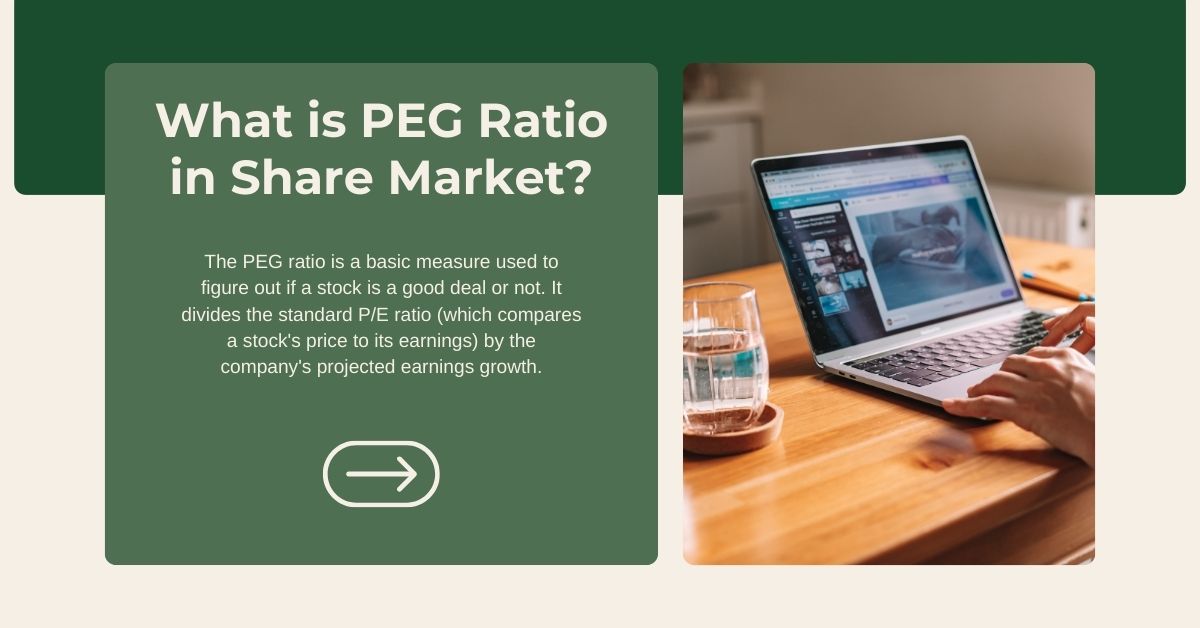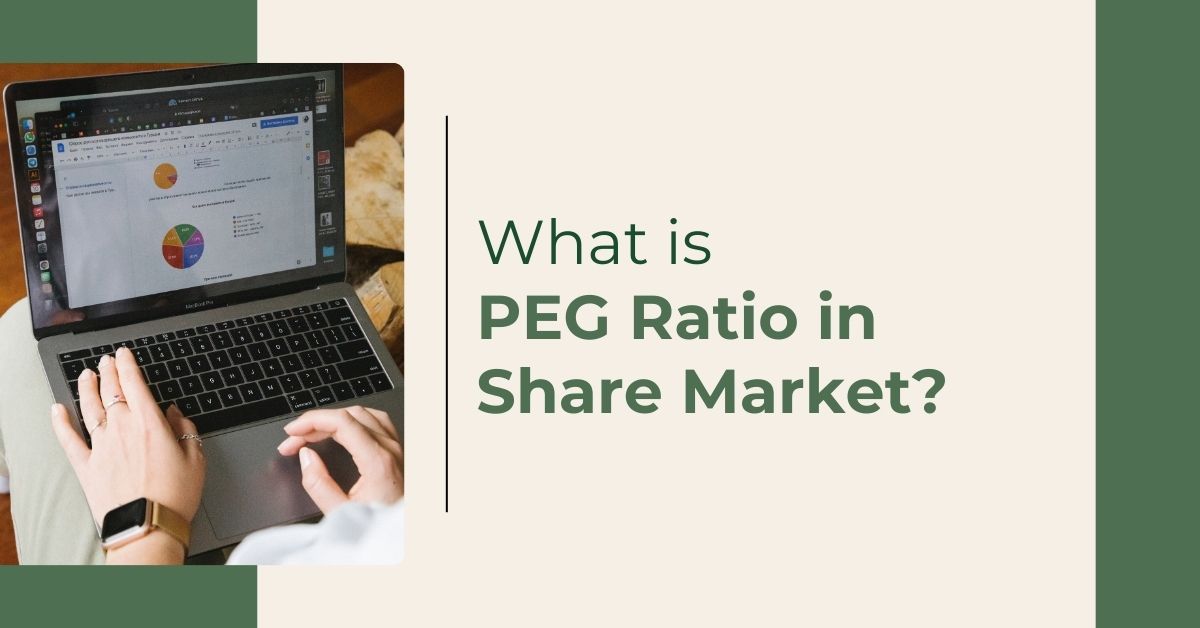The price/earnings-to-growth ratio, or PEG ratio, is a measure that helps investors value stocks using a company’s market price, earnings, and future growth potential. Compare the PEG ratio to the price-to-earnings ratio (P/E ratio), a similar statistic that determines how expensive a stock is by comparing its stock price to earnings. The PEG ratio can help decide if a stock is overvalued or undervalued.
What is PEG Ratio in Share Market?

The PEG ratio is a basic measure used to figure out if a stock is a good deal or not. It divides the standard P/E ratio (which compares a stock’s price to its earnings) by the company’s projected earnings growth.
A smaller PEG ratio often means the company is undervalued, whereas a greater one signals that it is overvalued. However, keep in mind that the PEG ratio is only one piece of the picture; other considerations should be considered before purchasing.
Think of this as buying a product. If a product is expensive, but you know it will become extremely popular and its price will skyrocket, it may still be a fantastic deal. The PEG ratio helps you determine a stock’s potential future value based on its present price and predicted growth.
How is PEG Ratio Calculated?
To calculate the PEG ratio, you’ll need two numbers: the P/E ratio and the predicted profits growth rate.
- Calculate the P/E ratio: Earnings per share (EPS) divided by the stock price is this.
- Calculate the estimated earnings growth rate: This is the predicted rate of future earnings growth for the company.
PEG Ratio = P/E Ratio / Expected Earnings Growth Rate
For example, if a corporation has a P/E ratio of 20 and an estimated profits growth rate of 15%, its PEG ratio is 20 / 15 = 1.33.
Remember that a lower PEG ratio typically suggests a possibly undervalued company, whereas a larger PEG ratio may indicate that it is overvalued.
What Does the PEG Ratio Tell You?
The PEG ratio provides a better understanding of a stock’s value by taking into account not just its present price relative to earnings (P/E ratio), but also how much those earnings are likely to rise in the future. It helps you determine whether you are paying a fair price for a stock’s potential growth.
A lower PEG ratio signifies that a company is undervalued, whereas a greater one indicates that it is overvalued. However, it is critical to remember that the PEG ratio is only one tool and should be used in conjunction with other financial metrics.
How to Interpret PEG Ratio?
A PEG ratio of less than one is generally regarded favorable, implying that a stock is inexpensive in relation to its predicted growth. This means you might pay less for each unit of earnings growth. A PEG ratio greater than one implies that the company is expensive, meaning that you are paying more for each unit of earnings growth.
However, it is critical to realize that the PEG ratio is a simplistic tool. Industry, company-specific risks, and economic factors can all have an impact on how much a stock is worth. Before making an investment decision, it is always best to use the PEG ratio in conjunction with other financial parameters and undertake extensive research.
Additionally, the quality of earnings increase is important. Even if the PEG ratio is low, a company with strong growth but low-quality earnings (for example, due to unsustainable operations) could still be overvalued.
Risks of Using the PEG Ratio
While the PEG ratio is a useful tool, it’s important to be aware of its limitations:
- Reliance on Estimates: The PEG ratio depends heavily on projected earnings growth, which can be inaccurate. Overly optimistic or pessimistic growth estimates can lead to misleading valuations.
- Industry Differences: Comparing PEG ratios across different industries can be misleading. Industries with inherently different growth rates might not be accurately assessed using the same PEG threshold.
- Ignoring Other Factors: The PEG ratio only considers price, earnings, and growth. It doesn’t account for other crucial factors like debt levels, cash flow, competitive advantage, and management quality.
- Short-Term Focus: The PEG ratio often uses short-term growth estimates, which might not reflect the company’s long-term potential.
- Quality of Earnings: A company might show high earnings growth but from unsustainable sources, leading to an artificially low PEG ratio.
As a result, the PEG ratio should be used as one of several techniques for evaluating a company, rather than depending primarily on it.
PEG Ratio vs P/E Ratio
| Feature | PEG Ratio | P/E Ratio |
|---|---|---|
| Focuses on | Value relative to future earnings growth | Current price relative to current earnings |
| Formula | P/E Ratio / Expected Earnings Growth Rate | Stock Price / Earnings per Share (EPS) |
| Interpretation | Lower ratio suggests potential undervaluation | Lower ratio suggests potential undervaluation |
| Limitations | Relies on estimated future growth | Ignores future growth potential |
| Consider alongside | Other financial metrics, industry comparisons | Other financial metrics |
What Is a Good PEG Ratio?
A PEG ratio of less than one is generally viewed as favorable. This shows that the stock’s price is relatively low in comparison to its predicted profits growth, indicating that it may be undervalued. However, it is important to stress that this is a general recommendation rather than a specific rule. Industry, company-specific circumstances, and economic conditions can all have an impact on what makes a healthy PEG ratio in certain situations.
Also, a low PEG ratio is no guarantee of future performance, and other aspects must be considered before making investing decisions.
What is a Negative PEG Ratio?
A negative PEG ratio tends to be a red flag. It usually happens when a corporation has negative earnings or is likely to have negative earnings growth. This indicates that the company is in financial problems, and its stock price may be heavily inflated.
While it is possible to have a negative PEG ratio due to an exceptionally high negative earnings growth rate, this is an uncommon occurrence that usually indicates significant business issues. Before making any investing decisions, it is critical that you do more study to determine the underlying causes of the negative PEG ratio.

